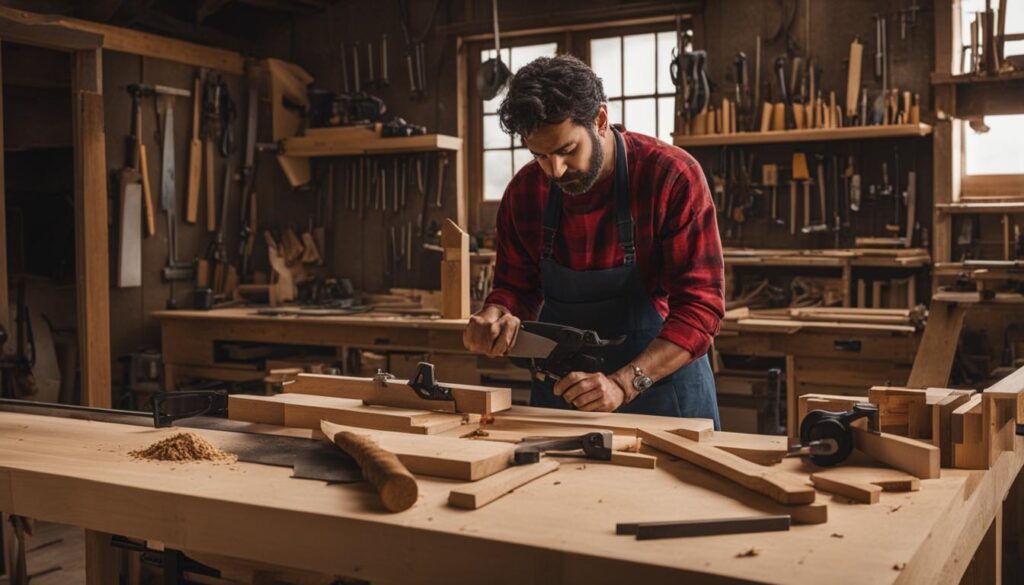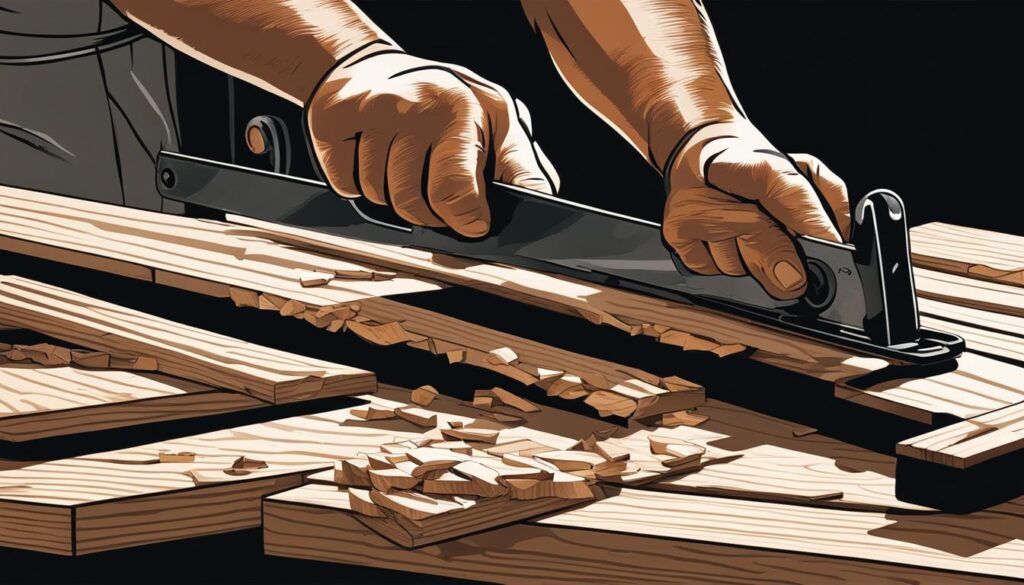We may earn money or products from the companies mentioned in this post.
Woodworking can be a fulfilling and rewarding hobby, but it can also be intimidating, especially if you’re new to it. In this guide, we’ll walk you through the basics of woodworking, from the essential tools you’ll need to the fundamental techniques every beginner should know. We’ll also provide you with some beginner woodworking projects to practice your skills and some tips and tricks to help you achieve better results.
Whether you’re looking to create functional pieces for your home or simply want to craft something unique, this guide is the perfect place to start. With a little practice and patience, you’ll soon be able to create beautiful and functional pieces that you can be proud of.
Key Takeaways
- Basic woodworking techniques are essential for beginners to learn.
- Woodworking requires some fundamental tools that every beginner should have in their toolkit.
- To get started, hone your skills with some beginner woodworking projects.
- Understand important safety measures before you begin any woodworking project.
- With practice and patience, you can achieve professional results in your woodworking projects.
Essential Woodworking Tools for Starters
Woodworking is a craft that requires a set of specific tools to achieve professional results. Whether you are a beginner or an experienced woodworker, having the right tools is essential to producing high-quality projects. In this section, we will introduce you to the basic woodworking tools every beginner should have in their toolkit.
| Tool | Description |
|---|---|
| Tape Measure | A tape measure is used to take precise measurements of wood pieces. Look for a tape measure with a locking mechanism to ensure accuracy. |
| Saw | A saw is used to cut wood pieces. A handsaw is suitable for beginners, but a circular saw or a jigsaw is also a good investment. |
| Chisel | A chisel is used to carve and remove small pieces of wood. Look for a set that includes different sizes for versatility. |
| Hammer | A hammer is used to drive nails and other fasteners into wood. Look for a hammer with a comfortable grip and a weight that feels good in your hand. |
| Screwdrivers | Screwdrivers are used to tighten and loosen screws. A set that includes different sizes and types of screwdrivers is ideal for beginners. |
| Drill | A drill is used to create holes in wood. Look for a cordless drill with adjustable speed settings for versatility. |
| Sanding tools | Sanding tools are used to smooth the surface of wood. A sanding block and sandpaper sheets are suitable for beginners, but an orbital sander is also a good investment. |
| Clamps | Clamps are used to hold wood pieces together while glue dries. Look for a variety of sizes and types of clamps for different projects. |
| Safety gear | Safety gear is essential when working with tools. Always wear eye protection, ear protection, and a dust mask to ensure your safety. |
These tools are the basic building blocks of any woodworking project. By investing in high-quality tools and taking care of them, you will set yourself up for success in your woodworking journey. With these woodworking basics in your toolkit, you’re ready to move on to the next step: learning essential woodworking techniques.
Must-Know Woodworking Techniques for Beginners
Now that you have your basic woodworking tools ready, it’s time to learn some essential woodworking skills. These fundamental techniques are the building blocks for any woodworking project and will help you achieve professional results.
Measuring and Marking
Accurate measuring and marking are crucial for a successful woodworking project. Use a measuring tape, square, and marking gauge to ensure your cuts are precise. Take your time and double-check your measurements before making any cuts.
Cutting
The most common cutting tool for woodworking projects is a handsaw. It’s essential to choose the right saw for the job and to use it correctly. Always follow the saw’s instructions and keep your fingers away from the blade. A miter saw or table saw are great options for more advanced woodworking projects.
Drilling
A drill is another essential tool in a woodworker’s arsenal. Use a drill press to make straight and accurate holes, and a handheld power drill for more versatile projects. Always wear safety goggles when drilling and clamp your workpiece securely before drilling.
Sanding
Sanding is an important step in any woodworking project. It smooths out rough edges and prepares the wood for finishing. A sanding block or power sander can make the process quicker and more efficient. Begin with coarse-grit sandpaper and gradually work your way up to finer grits for a smooth and polished finish.
Joining
Joining refers to the process of connecting two pieces of wood together. Common joining techniques include doweling, mortise and tenon joints, and pocket hole joinery. Each technique has its own advantages and disadvantages, and the right one for a project depends on the type of wood and the desired outcome.
Remember, practice makes perfect when it comes to woodworking techniques. Don’t be discouraged if your first few attempts don’t go as planned. With time and practice, you’ll develop the skills and confidence to take on more advanced projects.
Beginner Woodworking Projects to Practice Your Skills
Now that you have a basic understanding of woodworking techniques and have assembled your toolkit, it’s time to put your skills into practice. These beginner woodworking projects will help you build confidence and develop your abilities.
1. Simple Shelves
Create your own minimalist wall-mounted shelves utilizing a few basic tools such as a saw, drill, and sandpaper. This project is an excellent way to build your confidence and practice drilling and joining techniques.
2. Cutting Board
A wooden cutting board is an essential tool for every kitchen, and it’s a straightforward project for novice woodworkers. All you’ll need is a saw, drill, sander, and some food-safe oil to keep your board in excellent condition.
| Materials You’ll Need: | Tools You’ll Need: |
|---|---|
| Hardwood board | Saw |
| Mineral Oil | Drill |
| Sandpaper | Sander |
3. Decorative Sign
This is a fun project that allows you to practice cutting and lettering techniques. You can design your custom sign or use stencils to create your lettering. It requires simple tools like a jigsaw, drill, and sandpaper, and you can add some personal flair with paint or stain.
4. Small Stool
Build a functional and straightforward stool that is perfect for small spaces. This project will help you develop your joining and measuring techniques and requires basic tools such as a saw, drill, and sandpaper.
| Materials You’ll Need: | Tools You’ll Need: |
|---|---|
| 1’x1′ wooden board | Saw |
| Wood Screws | Drill |
| Sandpaper | Sander |
5. Picture Frames
This is an ideal project for practicing your measuring, cutting, and joining techniques. You can make custom-sized frames to display your favorite photos or artwork. It requires basic tools like a saw, drill, and sandpaper, and you can add some finishing touches with paint or stain.
- Hardwood board
- Glass Pane
- Sawtooth Hangers
- Wood Screws
- Drill
- Sander
- Sandpaper
These beginner woodworking projects are a great way to put your newly acquired skills and knowledge into practice. They are simple, functional, and rewarding projects that will help you develop your skills and build confidence. So, get started today and enjoy the satisfaction of creating something with your own hands.
Woodworking Tips and Tricks for Success
Woodworking can be a challenging but rewarding hobby or profession. Here are some tips and tricks to help you achieve success:
Choose the Right Wood
Choosing the right wood for your project is crucial. Different woods have varying characteristics that can affect the appearance and durability of your finished piece. Consider factors such as grain pattern, color, and hardness when selecting wood.
Understand Grain Direction
Understanding the grain direction of your wood is essential when cutting, planing, and sanding. Cutting against the grain can cause tear-out and ruin your workpiece. Always plan your cuts and sanding direction according to the wood’s grain.
Use Clamps Effectively
Clamps are essential for holding your workpiece steady while you work on it. Use clamps to secure your workpiece to the workbench or hold two pieces of wood together while the glue dries. Make sure the clamps are tight enough to hold the wood firmly but not so tight as to damage it.
Maintain Your Tools
Maintaining your tools is crucial for their longevity and performance. Keep your tools clean and oiled to prevent rust and corrosion. Sharpen your cutting tools regularly to ensure clean and precise cuts.
“Measure twice, cut once.” -Unknown
Never rush your work. Take the time to measure accurately and plan your cuts before making them. This will minimize mistakes and reduce waste.
- Wear Safety Gear
- Start Small
- Practice, Practice, Practice
Wearing safety gear such as eye protection, gloves, and a dust mask is important when working with power tools and wood dust. Start with small projects to build your confidence and skills, and don’t be afraid to make mistakes. The more you practice, the more you’ll learn and improve.
Remember, woodworking is a craft that takes time and patience to master. With these tips and tricks, you’ll be well on your way to success!
Conclusion
Thank you for reading our guide to basic woodworking techniques. We hope that you have found it informative and helpful in kickstarting your woodworking journey.
Practice Makes Perfect
Remember that woodworking is a skill that requires practice and patience. Don’t be discouraged if your first few projects don’t turn out perfectly. Keep practicing and learning, and soon you’ll be creating beautiful and functional pieces that you can be proud of.
Stay Safe
Always prioritize safety in your woodworking projects. Wear appropriate safety gear, such as eye and ear protection, and follow safety guidelines for each tool and technique. Accidents can happen, but taking precautions can help prevent them.
Keep Learning
Woodworking is a vast and fascinating field. Keep expanding your knowledge and skills by exploring different techniques, tools, and materials. Join a woodworking community or take classes to learn from others and continue to improve.
With the skills and knowledge you’ve gained from this guide, you’re now equipped to tackle a wide range of woodworking projects. Good luck on your woodworking journey!
FAQ
What are the basic woodworking tools every beginner should have?
The essential woodworking tools for beginners include measuring and marking tools (such as a tape measure and marking gauge), saws (such as a handsaw and a circular saw), chisels, a hammer, a drill with drill bits, a sander, and clamps.
What are some must-know woodworking techniques for beginners?
Some fundamental woodworking techniques for beginners include measuring and marking, cutting (with a saw or a chisel), drilling, sanding, and joining (using methods like nails, screws, or wood glue).
Can you suggest some beginner woodworking projects?
Certainly! Some beginner woodworking projects to practice your skills include building simple shelves, crafting cutting boards, creating small furniture items like a step stool or a plant stand, and making wooden picture frames.
Do you have any tips and tricks for successful woodworking?
Absolutely! Here are some valuable tips and tricks for woodworking success: choose the right type of wood for your project, understand the direction of the wood grain, use clamps effectively to secure pieces together, maintain your tools regularly for optimal performance, and always prioritize safety by wearing appropriate protective gear and following proper techniques.
Affiliate Disclosure: This post may contain affiliate links. If you purchase through our link, we may receive a small commission, but at no additional cost to you. For more information, please see our Disclosure statement.



